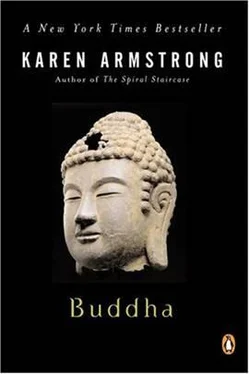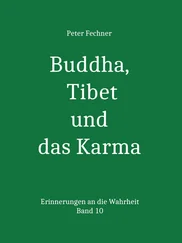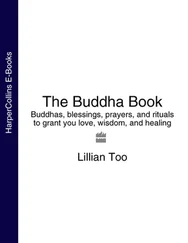But when he faced his five former companions in the Deer Park, the Buddha had to begin somewhere. How was he going to allay their suspicions? He would have to give some kind of logical explanation of the Four Noble Truths. We do not know what he actually said to the five bhikkhus that day. It is most unlikely that the discourse that is called the First Sermon in the Pali texts is a verbatim report of his preaching on that occasion. When the scriptures were compiled, the editors probably hit upon this sutta, which conveniently sets forth the essentials, and inserted it into the narrative at this point. But in some ways this First Sermon was appropriate. The Buddha was always careful to make his teachings fit the needs of the people he was addressing. These five bhikkhus were worried about Gotama’s abandonment of asceticism, and so in this sutta the Buddha began by reassuring them, explaining the theory behind his Middle Way. People who had “Gone Forth” into holiness, he said, should avoid the two extremes of sensual pleasure, on the one hand, and excessive mortification on the other. Neither was helpful, because they did not lead to Nibbana. Instead, he had discovered the Eightfold Path, a happy medium between these two alternatives, which, he could guarantee, would lead the monks directly to enlightenment.
Next, the Buddha outlined the Four Noble Truths: the Truth of Suffering, the Truth of the Cause of Suffering, the Truth of the Cessation of Suffering or Nibbana, and the Path that led to this liberation. However, these truths were not presented as metaphysical theories but as a practical program. The word dhamma denotes not only what is, but what should be. The Buddha’s Dhamma was a diagnosis of the problem of life and a prescription for cure, which must be followed exactly. Each of the Truths had three components in his sermon. First, he made the bhikkhus see the Truth. Next, he explained what had to be done about it: suffering had to be “fully known”; Craving, the Cause of Suffering, had to be “given up”; Nibbana, the Cessation of Suffering, had to “become a reality” in the heart of the Arahant; and the Eightfold Path must be “followed.” Finally, the Buddha explained what he had achieved: he had understood dhukkha “directly”; he had abandoned craving; he had experienced Nibbana; he had followed the Path to its conclusion. It was, he explained, when he had proved to himself that his Dhamma really worked and that he had actually completed the program, that his enlightenment had been complete: “I have achieved the final release!” he had cried triumphantly. He had indeed been liberated from samsara, he knew that the Middle Way was the true Path, and his own life and person proved it.
The Pali text tells us that as he listened to the Buddha’s sermon, Kondanna, one of the five bhikkhus, began to experience his teaching “directly.” It “rose up” in him, as if from the depths of his own being. It was as though he recognized it- had always known it. This is the way the scriptures always describe a new disciple’s conversion to the Dhamma. This was no mere notional assent to a creed. The Buddha was really holding an initiation ceremony in the Deer Park. Like a midwife, he was assisting at the birth of an enlightened human being, or, to use his own metaphor, he was drawing the sword from the scabbard and the snake from its slough. When the gods, who had gathered in the Deer Park to listen to this First Sermon, saw what was happening to Kondanna, they cried out joyfully: “The Lord has set the Wheel of the Dhamma in motion in the Deer Park of Varanasi!” The cry was taken up by the gods in one heaven after another, until it reached the abode of Brahma himself. The earth shook and was filled with a light more radiant than any of the gods. “Kondanna knows! Kondanna knows!” the Buddha exclaimed in delight. Kondanna had become what later Buddhist tradition would call a “stream-enterer” ( sotapanna ) . He had not yet been fully enlightened, but his doubts had disappeared, he was no longer interested in any other dhamma, and he was ready to immerse himself in the Buddha’s method, confident that it would carry him forward to Nibbana. He asked to be admitted to the Buddha’s Sangha. “Come, bhikkhu,” the Buddha replied. “The Dhamma has been preached to good effect. Live the holy life that will end your suffering once and for all.”
But the Pali texts include another version of this first teaching session in the Deer Park. This describes a much longer and quite different process. The Buddha instructed the bhikkhus in pairs, while the other three went off to Varanasi to beg enough food for all six of them. It has been suggested that in these more intimate tutorials, the Buddha was initiating the bhikkhus in his special yoga, introducing them to the practice of “mindfulness” and the “immeasurables.” Certainly meditation was indispensable to enlightenment. The Dhamma could not become a reality or understood “directly” unless the aspirants were also sinking deeply into themselves and learning to put their minds and bodies under the Buddha’s yogic microscope. Kondanna could not have become a “stream-enterer” and gained his special “direct knowledge” of the Dhamma simply by listening to a sermon and accepting its truths on hearsay. The truths of Suffering and Craving could not be properly understood until the bhikkhus had become aware of them within the minutiae of their own experience; the Eightfold Path, which he preached, included the discipline of meditation. The instruction of these five bhikkhus almost certainly took longer than a single morning; even if they were already accomplished yogins and versed in the ethic of ahimsa, the Dhamma needed time to take effect. At all events, the Pali texts tell us, not long after the Dhamma “rose up” in Kondanna, Vappa, Bhaddiya, Mahanama and Assaji became “stream-enterers” too.
The reasoned formulation of the Dhamma was complementary to the practice of meditation, which enabled aspirants to “realize” it. Through yoga, the bhikkhus could identify with the truths that the doctrine tried to express. One of the most frequent subjects of Buddhist meditation was what was called the Chain of Dependent Causation ( Paticcasamuppada ) , which the Buddha probably developed at a later stage as a supplement to the Truth of Suffering, even though the Pali texts say that he was contemplating this Chain immediately before and after his enlightenment. The Chain traces the life cycle of a sentient being through twelve conditioned and conditioning links, illustrating the transitory nature of our lives and showing how each person is perpetually becoming something else.
On [1] ignorance depends [2] kamma; on kamma depends [3] consciousness; on consciousness depends [4] name and form; on name and form depends [5] the sense organs; on the sense organs depends [6] contact; on contact depends [7] sensation; on sensation depends [8] desire; on desire depends [9] attachment; on attachment depends [10] existence; on existence depends [11] birth; on birth depends [12] dukkha; old age and death, sorrow, lamentation, misery, grief and despair.
This Chain became central to Buddhist teaching, but it is not easy to understand. Those who find it somewhat daunting can draw comfort from the fact that the Buddha once rebuked a bhikkhu who claimed to find it easy. It should be regarded as a metaphor, which seeks to explain how a person can be reborn when, as the Buddha was beginning to conclude, there was no Self to persist from one life to another. What was it that was born again? Is there a law which links rebirth with dukkha ?
Читать дальше












